Lecture
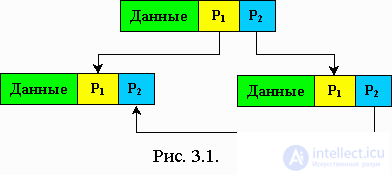



In programming, doubly-linked lists are often summarized as follows: as the value of the Rptr field of the last link, they take a link to the title link, and as the value of the Lptr field of the title link, the link to the last link. The list closes into a kind of ring: by following the links, you can go from the last link to the title link and vice versa.

ABOUT  Operations over doubly linked lists:
Operations over doubly linked lists:
- create a list item;
- Search for an item in the list;
- insert an item in the specified place in the list;
- removal of the specified item from the list.
Any single-linked list can be viewed as a stack. However, the list has an advantage over the stack in the form of a one-dimensional array, since its size has not been predefined.
Stack operations applicable to lists
one). To add an element to the stack, it is necessary in the algorithm to replace the pointer Lst with the pointer Stack (operation Push (S, X)).
P = GetNode
Info (P) = X
Ptr (P) = Stack
Stack = P
If Stack = Nil then Print “The stack is empty”
Stop
P = Stack
X = Info (P)
Stack = Ptr (P)
FreeNode (P)
Implementation in Pascal:
Stack
Instead of the Lst pointer, the Stack pointer is used.
Push procedure (S, X)
procedure Push (var Stack: PNode; X: Integer);
var
P: PNode;
begin
New (P);
P ^ .Info: = X;
P ^ .Next: = Stack;
Stack: = P;
end;
Check for emptiness (Empty)
function Empty (Stack: PNode): Boolean;
begin
If Stack = nil then Empty: = True Else Empty: = False;
end;
Pop procedure
procedure Pop (var X: Integer; var Stack: PNode);
var
P: PNode;
begin
P: = Stack;
X: = P ^ .Info;
Stack: = P ^ .Next;
Dispose (P);
end;
Queue operations that apply to lists.
A pointer to the beginning of the list is taken as the pointer to the beginning of the queue F, and a pointer R that points to the last element of the list is taken as the pointer to the end of the queue.
The delete operation from the queue must pass from its beginning.
P = F
F = Ptr (P)
X = Info (P)
FreeNode (P)
If F = Nil then Print “The queue is empty”
Stop
The insert operation in the queue should be carried out to its end.
P = GetNode
Info (P) = X
Ptr (P) = Nil
Ptr (R) = P
R = P
Implementation in Pascal:
procedure Remove (var X: Integer; Fr: PNode);
var
P: PNode;
begin
New (P);
P: = Fr;
X: = P ^ .Info;
Fr: = P ^ .Next;
Dispose (P);
end;
function Empty (Fr: PNode): Boolean;
begin
If Fr = nil then Empty: = True Else Empty: = False;
end;
procedure Insert (X: Insert; var Re: PNode);
var
P: PNode;
begin
New (P);
P ^ .Info: = X;
P ^ .Next: = nil;
Re ^ .Next: = P;
end;
For more efficient use of computer memory (to eliminate garbage , that is, unused items) when working with lists it creates a free list that has the same field format as functional lists.
If the functional lists have a different format, then it is necessary to create a free list of each functional list.
The number of items in the free list must be determined by the task that the program solves. As a rule, a free list is created in the memory of the machine as a stack. In this case, the creation ( GetNode ) of a new element is equivalent to fetching an element of a free stack, and the FreeNode operation is adding a free element to a free stack.
Suppose we need to create an empty list of the type of stack (Fig. 3.6) with a pointer to the beginning of the list - AVAIL. We will develop procedures that allow us to create an empty list item and free an item from the list.

We will develop a procedure that will create an empty list item with a pointer R.
To implement the GetNode operation, you need to assign the pointer value of the beginning of the free list to the pointer of the generated element, and move the pointer to the next element.
P = Avail
Avail = Ptr (avail)
Before this, you need to check whether there are items in the list. The void of a free list (Avail = Nil) is equivalent to the overflow of a functional list.
If Avail = Nil then Print “Overflow” Stop
Else
P = Avail
Avail = Ptr (avail)
Endif
When the Nod (P) element is freed from the functional list by the FreeNode (P) operation, it is entered into the free list.
Ptr (P) = avail
Avail = P
The standard operations of returning a vacated list item to a pool of free elements do not always have an effect if nonlinear multiply connected lists are used.
The first method of disposal is the counter method. The field of the counter which counts the number of links to this element is inserted into each element of the multiply linked list. When the element counter is in the zero state, and the element pointer fields are in the nil state, this element can be returned to the pool of free elements.
The second method is garbage collection (marker method). If a connection is established with some element, then the one-bit element field (marker) is set to “1”, otherwise - to “0”. The overflow signal looks for elements whose marker is set to zero, i.e., the garbage collection program is turned on, which scans all allocated memory and returns all elements not marked with a marker to the free list.
A single-linked list can be viewed only sequentially, starting from the head (from the beginning) of the list. If you need to view the previous item, then you need to go back to the top of the list. This is a disadvantage of simply linked lists compared to static structures like an array. The list structure shows its advantages when the number of elements in the list is large, and insertion or deletion must be made inside the list.
Example:
You must insert an element X between 5 and 6 elements into an existing array.
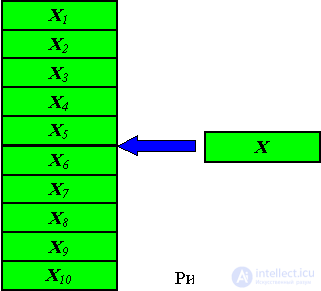
To perform this operation in the array, you need to “omit” all elements starting from X6 - increase their indices by one. As a result of insertion, we get the following array (fig. 3.7, 3.8):
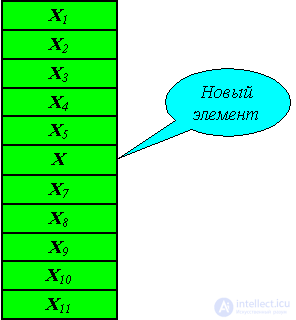
This procedure can take a very significant time. In contrast, in the linked list, the insert operation consists in changing the value of 2 pointers and generating a free element. Moreover, the time spent on this operation is constant and does not depend on the number of items in the list.
We define the element after which it is necessary to insert the element into the list. The insertion is done using the InsAfter procedure (Q, X), and the deletion is done DelAfter (Q, X).
At the same time, the working pointer P will point to the element after which it is necessary to insert or delete (Fig. 29).

Example:
Let it be necessary to insert a new element with information field X after the element pointed to by the working pointer P.
For this:
one) You need to generate a new item.
Q = GetNode
2) Assign the value X to the information field of this element.
Info (Q) = X
3) Insert received item.
Ptr (Q) = Ptr (P)
Ptr (P) = Q
This is the InsAfter (Q, X) procedure.
Suppose you need to delete the list item that follows the item pointed to by the working pointer P.
For this:
Q = Ptr (P)
2) In the variable X, save the value of the information field of the element to be deleted.
X = Info (Q)
3) Change the value of the pointer to the element to be deleted with the value of the pointer to the next element and delete it.
Ptr (P) = Ptr (Q)
FreeNode (Q)
This is the DelAfter (P, X) procedure.
In Pascal, the procedures described above will be as follows:
procedure InsAfter (var Q: PNode; X: Integer);
var
Q: PNode;
begin
New (Q);
Q ^ .Info: = X;
Q ^ .Next: = P ^ .Next;
P ^ .Next: = Q;
procedure DelAfter (var Q: PNode; var X: Integer);
var
Q: PNode;
begin
Q: = P ^ .Next;
P ^ .Next: = Q ^ .Next;
X: = Q ^ .Info;
Dispose (Q);
end;
Task 1.
It is required to view the list and delete elements whose information fields are equal to 4.
Let P - work pointer, at the beginning of the procedure P = Lst. We also introduce a pointer Q, which is one element behind P. When the pointer P finds an element, the latter will be deleted relative to the pointer Q as a subsequent element.
Q = Nil
P = Lst
While P <> Nil do
If Info (P) = 4 then
If Q = Nil then
Pop (lst)
FreeNode (P)
P = Lst
Else
DelAfter (Q, X)
Endif
Else
Q = P
P = Ptr (P)
Endif
Endwhile
Task 2.
Dan is ordered in ascending Info - list of fields. It is necessary to insert into this list an element with the value X, without disturbing the orderliness of the list.

Let X = 16. The initial condition: Q = Nil, P = Lst. The insertion of the element should occur between the 3rd and 4th elements (Fig.3.10).
Q = Nil
P = Lst
while (P <> Nil) and (X> Info (P)) do
Q = P
P = Ptr (P)
Endwhile
if Q = Nil then
Push (Lst, X)
Endif
InsAfter (Q, X)
Implementation of examples in Pascal:
Task 1:
Q: = nil;
P: = Lst;
While P <> nil do
If P ^ .Info = 4 then
begin
If Q = nil then
begin
Pop (Lst);
P: = Lst;
end
Else Delafter (Q, X);
End;
Else
begin
Q: = P;
P: = P ^ .Next;
end;
end;
Task 2:
Q: = nil;
P: = Lst;
While (P <> nil) and (X> P ^ .Info) do
begin
Q: = P;
P: = P ^ .Next;
end;
{This point is inserted}
If Q = nil then Push (Lst, X);
InsAfter (Q, X);
End;
To create a list with a header, an additional element is entered at the top of the list, which may contain information about the list (Fig. 3.11).

A dynamic variable is often placed in the list header, containing the number of elements in the list (not counting the title itself).
If the list is empty, then only the list header remains (Fig. 3.12).

It is also convenient to enter the value of the end of list pointer in the header information field. Then, if the list is used as a queue, then Fr = Lst, and Re = Info (Lst).
The header information field can be used to store the working pointer when viewing the P = Info (Lst) list. That is, the header is a data structure descriptor.
A doubly linked list can be a non-linear data structure if the second pointers specify an arbitrary order of the elements (Fig. 3.13).

LST1 is a pointer to the beginning of the 1st list (oriented by pointer P1). It is linear and consists of 5 elements.
The 2nd list is formed from the same elements, but in an arbitrary sequence. The beginning of the 2nd list is the 3rd element, and the end of the 2nd element.
In the general case, the element of the list structure can contain as many pointers as it wishes, that is, it can indicate any number of elements.
There are 3 signs of differences in nonlinear structure:
1) Any element of the structure can refer to any number of other elements of the structure, that is, it can have any number of pointer fields.
2) Any number of other elements of this structure may refer to this structure element.
3) Links may have weight, that is, a hierarchy of links is implied.
Imagine that there is a discrete system, in the state graph of which nodes are states and edges are transitions from state to state (Fig. 3.14).
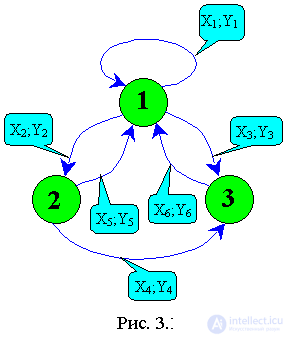
The input signal to the system is X. The reaction to the input signal is the generation of the output signal Y and the transition to the corresponding state.
The state graph of a discrete system can be represented as a doubly connected nonlinear list. In this case, information on the system states and edges must be recorded in the information fields. The pointers of the elements should form the logical edges of the system (Fig. 3.15).
To implement the above:
1) a list should be created that displays the state of the system (1, 2, 3);
2) lists should be created that reflect the transitions along edges from the corresponding states.
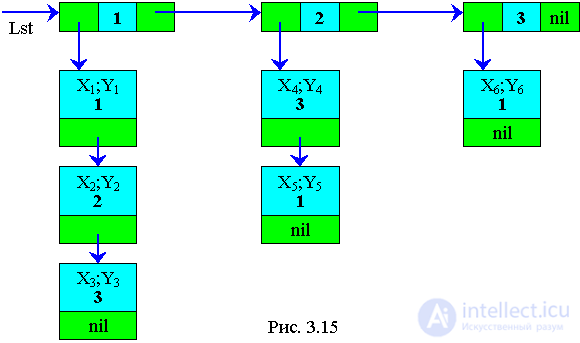
In general, when implementing a multiply-connected structure, a network is obtained.
test questions
Comments
To leave a comment
Structures and data processing algorithms.
Terms: Structures and data processing algorithms.